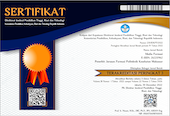IDENTIFIKASI BIOKIMIA DAN AKTIVITAS ANTIBAKTERI ISOLAT BAKTERI ASAM LAKTAT LIMBAH SAYUR BAYAM
Abstract
Lactic acid bacteria (LAB) works in carbohydrate metabolism to fight against pathogenic bacteria through peptide compounds. It can be obtained from vegetables containing carbohydrates and produces organic acid metabolites, hydrogen peroxide, and bacteriocin with antimicrobial properties. These antimicrobial compounds inhibit the growth of gram-positive and gram-negative bacteria, including the pathogenic and spoilage. This study determines the antibacterial activity of LAB isolates from spinach vegetable waste using the pour method. The biochemical testing includes TSIA, Indol, MR_VP, motility, and temperature and salt resistance tests. Furthermore, activity testing uses the disc diffusion method with Mueller Hinton Agar media against Basillus subtilis Escherichia coli, Staphylococcus aureus, Staphylococcus epidermidis, Streptococcus mutans, Salmonella thypimurium, and Propionibacterium acnes. Preparation of the test sample was carried out by inoculating the LAB isolate stock for 1x24 hours at 37 ° C. The results of biochemical identification showed the isolates fermented glucose and were negative in the indole and VP testing. Also, it was positive in MR testing, which was marked by acidic pH, non-motile nature, active at 37 ° C, and resistant to several salt concentrations. The antibacterial activity based on univariate analysis showed differences in the activity of each test bacteria. There was a significant difference between isolates A to B, D, and positive control. The isolates obtained included the LAB group from the Lactobacillaceae family, genus Lactobacillus sp. The best activity was shown in isolate A with a broad spectrum.
Keywords: identification, biochemistry, lactic acid bacteria, antibacterial, spinach, isolates A, B, and D.
Bakteri asam laktat (BAL) merupakan bakteri pembentuk asam laktat dalam metabolisme karbohidrat. BAL mempunyai peranan penting untuk melawan bakteri patogen melalui senyawa peptida. BAL dapat diperoleh dari sayuran yang mengandung karbohidrat. BAL ini mampu menghasilkan metabolit asam organik, hidrogen peroksida, dan bakteriosin yang bersifat sebagai antimikroba. Senyawa antimikroba ini mampu menghambat pertumbuhan bakteri gram positif dan gram negatif, termasuk bakteri patogen dan bakteri pembusuk Tujuan penelitian mengidentifikasi secara biokimia dan menentukan aktivitas antibakteri isolat BAL dari limbah sayur Bayam. Metode isolasi BAL menggunakan metode tuang, pengujian biokimia meliputi uji TSIA, Indol, MR_VP, motilitas, ketahanan suhu dan ketahanan garam. Sedangkan pengujian aktivitas menggunakan metode disc diffution agar menggunakan media Mueller Hinton Agar terhadap bakteri Basillus subtilis Escherichia coli, Staphylococcus aureus, Staphylococcus epidermidis, Streptococcus mutans, Salmonella thypimurium, dan Propionibacterium acnes. Penyiapan sampel uji dilakukan dengan menginokulasi stok isolat BAL selama 1x24 jam pada suhu 37 °C. Hasil identifikasi biokimia menunjukkan bahwa isolat BAL mampu memfermentasi glukosa, negatif pada pengujian indol dan VP , positif pada pengujian MR di tandai dengan diperolehnya pH asam, bersifat non motil, hidup pada suhu 37°C, serta tahan terhadap beberapa konsentrasi garam. Hasil pengujian aktivitas antibateri berdasarkan analisis univariate menunjukkan perbedaan aktivitas dari masing-masing bakteri uji menunjukkan perbedaan sigifikan antara isolat A terhadap isolat B, D dan Kontrol positif. Kesimpulan isolat yang diperoleh termasuk kelompok BAL dari famili Lactobacillaceae, genus Lactobacillus sp dan aktivitas terbaik di tunjukkan pada isolat A dan bersifat spectrum luas.
Kata kunci : identifikasi, biokimia, bakteri asam laktat, antibakteri, Bayam, isolat A, B,dan D.
Full Text:
PDF (Bahasa Indonesia)References
Bintang, M. (2010) Biokimia.
Cappuccino, J. G. and Sherman, N. (2014) Manual Laboratorium MiKrobiologi. 8th edn. Jakarta: Penerbit Buku Kedokteran EGC.
Emmawati, A. et al. (2015) ‘KARAKTERISASI ISOLAT BAKTERI ASAM LAKTAT DARI MANDAI YANG BERPOTENSI SEBAGAI PROBIOTIK (Characterization of Lactic Acid Bacteria Isolates from Mandai Function as Probiotic)’, Jurnal Agritech, 35(02), p. 146. doi: 10.22146/agritech.9400.
Korhonen, J. (2010) Antibiotic Resistance of Lactic Acid Bacteria. Dissertation in Forestry and Natural Sciences ISBN: 978-952-61-0097-5. Eastern Finland: Publications of the University of Eastern Finland.
Kursia, S. et al. (2019) ‘Optimasi produksi bakteri asam laktat dari limbah sayuran hijau’, in, pp. 1–4.
Kusmiati (2002) ‘Aktivitas bakteriosin dari bakteri Leuconostoc mesenteroides Pbac1 pada berbagai media’, Pusat Penelitian Bioteknologi LIPI Universitas Indonesia Fakultas Matematikan dan Ilmu Pengetahuan, 6(1), pp. 1–7.
Lay, B. (1994) Analisis Mikroba di Laboratorium. Jakarta: PT. Raja Grafika Persada.
Nasution, F. S. (2012) ‘IDENTIFIKASI DAN KARAKTERISASI BAKTERI ASAM LAKTAT PADA KOTORAN AYAM BROILER SEBAGAI AGENSI PROBIOTIK’, Digital Repository Universitas Negeri Medan. Available at: http://digilib.unimed.ac.id/id/eprint/10255.
Ogunbanwo, S. T., Sanni, A. I. and Onilude, A. A. (2003) ‘Characterization of bacteriocin produced by Lactobacillus plantarum F1 and Lactobacillus brevis OG1’, African Journal of Biotechnology, 2(8), pp. 223–235. doi: 10.5897/ajb2003.000-1045.
Sari, R., Apridamayanti, P. and Octaviani, M. (2018) ‘Optimasi Aktivitas Bakteriosin yang Dihasilkan oleh Bakteri Lactobacillus plantarum dari Minuman Ce Hun Tiau Optimization of Bacteriocin Activity Produced by Lactobacillus plantarum Bacteria from Ce Hun Tiau Beverages’, 5(1), pp. 1–6.
Sasmita et al. (2018) ‘Isolasi Dan Identifikasi Bakteri Asam Laktat Dari Liur Basa (Limbah Sayur Bayam Dan Sawi)’, As-Syifaa Jurnal Farmasi, 10(2), pp. 141–151.
Wedajo, B. (2015) ‘Lactic Acid Bacteria: Benefits, Selection Criteria and Probiotic Potential in Fermented Food’, Journal of Probiotics & Health, 03(02). doi: 10.4172/2329-8901.1000129.
Yuni and Sari, N. M. (2003) ‘ISOLASI, KARAKTERISASI, DAN IDENTIFIKASI DNA BAKTERI ASAM LAKTAT (BAL) YANG BERPOTENSI SEBAGAI ANTIMIKROBA DARI FERMENTASI MARKISA KUNING (Passiflora edulis var. flavicarpa)’, 21(6), pp. 465–499. Available at: http://scholar.unand.ac.id/id/eprint/8203
DOI: https://doi.org/10.32382/mf.v16i1.1369
Refbacks
- There are currently no refbacks.
Kontak Editor
Hendra Stevani
Jurusan Farmasi Poltekkes kemenkes Makassar
email : hendra@poltekkes-mks.ac.id

This work is licensed under a Creative Commons Attribution-ShareAlike 4.0 International License.




.png)


